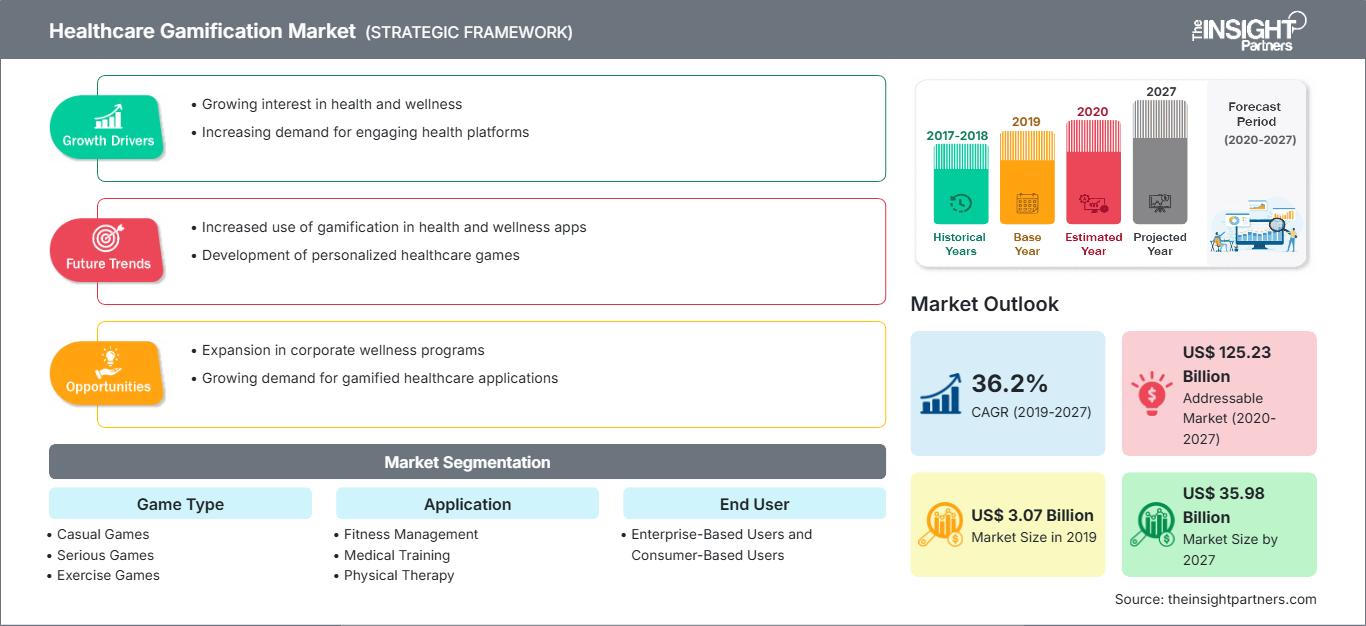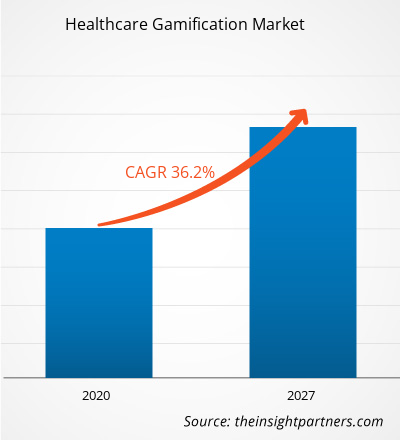[Informe de investigación] Se prevé que el mercado de la gamificación en el sector sanitario alcance los 35.982,7 millones de dólares en 2027, frente a los 3.072,5 millones de dólares en 2019. Se estima que el mercado crecerá con una tasa de crecimiento anual compuesta (TCAC) del 36,2% entre 2020 y 2027.
El crecimiento del mercado se atribuye a factores como la creciente adopción de la gamificación en la atención médica y el aumento en el número de lanzamientos tecnológicos. Sin embargo, las dificultades para lograr la fidelización de los usuarios a largo plazo podrían frenar dicho crecimiento.
Perspectivas del mercado
Mayor adopción de la gamificación en la atención médica
La introducción de los juegos en el tratamiento de la salud se inició a principios de 1975 y ha desempeñado un papel fundamental en la ludoterapia. Además, los juegos han cobrado relevancia recientemente en cuanto a sus aspectos terapéuticos gracias a la integración de la inteligencia artificial y la realidad aumentada en el sector sanitario. Los juegos ofrecen a los pacientes la posibilidad de expresarse, algo que no suele ser posible en la mayoría de los casos, lo que ayuda a los profesionales a diseñar una terapia más eficaz y, por consiguiente, a obtener mejores resultados. Por lo tanto, se prevé que la creciente prevalencia de enfermedades crónicas, como las enfermedades mentales y las afecciones musculoesqueléticas y ortopédicas, que pueden tratarse en cierta medida con tecnologías de videojuegos, aumente la demanda de ludoterapia en la atención sanitaria. Se ha comprobado que la ludoterapia es útil para tratar a pacientes jóvenes, familiarizados con la interacción constante con la tecnología a lo largo de su vida. Asimismo, la introducción de nuevas tecnologías, como la realidad aumentada (RA) y la realidad virtual (RV), en el sector sanitario está ayudando a los profesionales a tratar las enfermedades mentales de los pacientes y a mejorar las sesiones de asesoramiento. Por ejemplo, en 2016, un equipo de diseñadores de videojuegos en Estados Unidos presentó una experiencia de realidad virtual profunda (DEEP-VR) que guía a los usuarios en un entorno subacuático para aprender a combatir los síntomas de la ansiedad y el estrés. Además, la incorporación de actividades físicas en los videojuegos permite integrar la realidad virtual en las terapias de rehabilitación. Por ejemplo, en octubre de 2017, estudiantes de la Universidad Rice crearon un videojuego llamado Equilibrium para fisioterapia pediátrica. El juego utiliza la Wii Balance Board junto con barras de equilibrio diseñadas a medida que motivan a los niños a mejorar su capacidad para caminar y aprender a mantener el equilibrio. De este modo, la creciente adopción de la gamificación con fines terapéuticos está impulsando el crecimiento del mercado de la gamificación en el ámbito sanitario.
Obtendrá personalización gratuita de cualquier informe, incluyendo partes de este informe, análisis a nivel de país y paquetes de datos de Excel. Además, podrá aprovechar excelentes ofertas y descuentos para empresas emergentes y universidades.
Mercado de la gamificación en el sector sanitario: Perspectivas estratégicas

-
Obtenga las principales tendencias clave del mercado que se describen en este informe.Esta muestra GRATUITA incluirá análisis de datos, que abarcarán desde tendencias de mercado hasta estimaciones y pronósticos.
Información basada en el tipo de juego
Según el tipo de juego, el mercado de la gamificación en el sector salud se segmenta en juegos casuales, juegos serios y juegos de ejercicio. En 2019, los juegos casuales representaron la mayor parte del mercado debido a su creciente adopción entre niños y adultos mayores de 50 años, gracias a sus beneficios para mejorar las habilidades cognitivas. Esta creciente demanda está impulsando a las empresas a ofrecer una amplia gama de juegos casuales divertidos. Sin embargo, se prevé que en los próximos años los juegos de ejercicio crezcan aún más, ya que incluyen juegos de fitness y de movimiento físico interactivo. Por otro lado, muchos proveedores de atención médica han colaborado con aplicaciones de ejercicio para fomentar hábitos saludables entre los usuarios. Por ejemplo, el gigante de la salud United Healthcare colaboró en un programa piloto con los creadores de 'Dance Dance Revolution' para desarrollar un juego apto para clases de gimnasia que mantuviera a los niños activos y evitara que se quedaran sentados.
Información basada en aplicaciones
El mercado de la gamificación en el sector salud, según su aplicación, se segmenta en gestión del fitness, formación médica, fisioterapia y otros. El segmento de gestión del fitness ostentó la mayor cuota de mercado en 2019. Asimismo, se prevé que este mismo segmento registre la mayor tasa de crecimiento anual compuesto (TCAC) durante el período de pronóstico.
Información basada en el usuario final
Según el tipo de usuario final, el mercado de la gamificación en el sector salud se segmenta en usuarios empresariales y usuarios particulares. El segmento de usuarios empresariales representó la mayor cuota de mercado en 2019 y se estima que registrará la mayor tasa de crecimiento anual compuesto (TCAC) durante el período de pronóstico.
Los actores del mercado de la gamificación en el sector salud, como Cognifit, Mango Health, Bunchball, Ayogo Health Inc., Fitbit, Inc., Akili Interactive Labs, Inc., Nike, Inc., Cohero Health, Inc., Higi Sh LLC y Mysugr, han implementado diversas estrategias, tanto orgánicas como inorgánicas, para aumentar sus ingresos y mejorar su posición en el mercado. Por ejemplo, en octubre de 2020, TrialCard Incorporated lanzó la versión 2.0 de Mango Health. Esta última versión ofrece a los proveedores de servicios de salud externos acceso al sólido conjunto de módulos de apoyo al paciente de Mango. Esta versión de la plataforma Mango formará parte de un programa integral de apoyo al paciente para el próximo lanzamiento de un nuevo oncolítico oral.
Perspectivas regionales del mercado de la gamificación en el sector sanitario
Los analistas de The Insight Partners han explicado en detalle las tendencias y los factores regionales que influyen en el mercado de la gamificación en el sector sanitario durante el período de previsión. Esta sección también analiza los segmentos y la geografía del mercado de la gamificación en el sector sanitario en Norteamérica, Europa, Asia Pacífico, Oriente Medio y África, y Sudamérica y Centroamérica.
Alcance del informe de mercado sobre gamificación en el sector sanitario
| Atributo del informe | Detalles |
|---|---|
| Tamaño del mercado en 2019 | 3.070 millones de dólares estadounidenses |
| Tamaño del mercado para 2027 | 35.980 millones de dólares estadounidenses |
| Tasa de crecimiento anual compuesto global (2019 - 2027) | 36,2% |
| Datos históricos | 2017-2018 |
| período de previsión | 2020-2027 |
| Segmentos cubiertos |
Por tipo de juego
|
| Regiones y países cubiertos |
América del norte
|
| Líderes del mercado y perfiles de empresas clave |
|
Densidad de los participantes en el mercado de la gamificación en el sector sanitario: comprensión de su impacto en la dinámica empresarial
El mercado de la gamificación en el sector salud está creciendo rápidamente, impulsado por la creciente demanda de los usuarios finales debido a factores como la evolución de las preferencias de los consumidores, los avances tecnológicos y una mayor conciencia de los beneficios del producto. A medida que aumenta la demanda, las empresas amplían su oferta, innovan para satisfacer las necesidades de los consumidores y aprovechan las tendencias emergentes, lo que impulsa aún más el crecimiento del mercado.

- Obtenga una visión general de los principales actores del mercado de la gamificación en el sector sanitario.
Mercado de la gamificación en el sector sanitario: por tipo de juego
- Juegos casuales
- Juegos serios
- Juegos de ejercicio
Mercado de la gamificación en el sector sanitario: por aplicación
- Gestión del fitness
- Formación médica
- Fisioterapia
- Otros
Mercado de la gamificación en el sector sanitario: por usuario final
- Usuarios empresariales
- Usuarios basados en el consumidor
Mercado de la gamificación en el sector sanitario – por geografía
-
América del norte
- A NOSOTROS
- Canadá
- México
-
Europa
- Francia
- Alemania
- Italia
- Reino Unido
- España
- El resto de Europa
-
Asia-Pacífico (APAC)
- Porcelana
- India
- Corea del Sur
- Japón
- Australia
- Resto de Asia-Pacífico
-
Oriente Medio y África (MEA)
- Sudáfrica
- Arabia Saudita
- Emiratos Árabes Unidos
- Resto de Oriente Medio y África
-
América del Sur y Central
- Brasil
- Argentina
- El resto de Sudamérica y Centroamérica
Perfiles de empresas
- Cognifit
- Mango Health
- Bunchball
- Ayogo Health Inc.
- Fitbit, Inc.
- Akili Interactive Labs, Inc.
- Nike, Inc.
- Cohero Health, Inc.
- Higi Sh LLC
- Mi sugr
- Análisis histórico (2 años), año base, pronóstico (7 años) con CAGR
- Análisis PEST y FODA
- Tamaño del mercado, valor/volumen: global, regional y nacional
- Industria y panorama competitivo
- Conjunto de datos de Excel
Informes recientes
Informes relacionados
Testimonios
Razón para comprar
- Toma de decisiones informada
- Comprensión de la dinámica del mercado
- Análisis competitivo
- Información sobre clientes
- Pronósticos del mercado
- Mitigación de riesgos
- Planificación estratégica
- Justificación de la inversión
- Identificación de mercados emergentes
- Mejora de las estrategias de marketing
- Impulso de la eficiencia operativa
- Alineación con las tendencias regulatorias






















 Obtenga una muestra gratuita para - Mercado de gamificación en el sector sanitario
Obtenga una muestra gratuita para - Mercado de gamificación en el sector sanitario